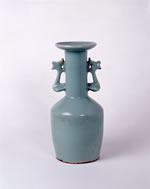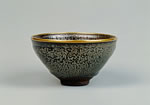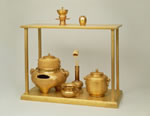National Treasure
Vase with phoenix-shaped handles, named “Bansei (ten thousand sounds)” Celadon
Longquan ware, Southern Song dynasty, 13th century
Height: 30.8cm, mouth diameter: 10.8cm, base diameter: 11.4cm
Provenance: Tokugawa Iemitsu (Third shogun of the Edo period)
→ Tofukumon-in (sister of Iemitsu, wife of Emperor Go-Mino-o)
→ Koben Hosshinno (Bishamon-do Temple head priest of royal origin)
Dates on display: Tuesday, May 19 – Sunday, June 28
Kuboso Memorial Museum of Arts, Izumi
Celadon produced in Longquan, China during the Southern Song dynasty, especially those known as “kinuta seiji (mallet-shaped celadon)” were among the most highly praised ceramics introduced to Japan since early times and passed down through generations. Kundaikan Sochoki, a record of ornamentation of public and private spaces for the Muromachi shogun family written by Noami, in considered one of the first to describe what was later known as kinuta seiji, though the use of such name actually began around early seventeenth century.
This vase is one of the most splendid examples of celadon vase with phoenix handles among the extant similar pieces in terms of form, size and color of the glaze, along with another work known as “Sensei (one thousand sounds)” housed in Yomei Bunko. According to Kaiki, a record of speech and action by a talented physician Yorakuin Konoe Iehiro, the latter piece was named Sensei by Emperor Go-Sai after Bai Juyi’s poem Wen ye zhen (Hearing the fulling blocks at night), the name Bansei was also thought to have been taken from the same poem after the vase was presented to Tofukumon-in from the third Tokugawa shogun Iemitsu.




















